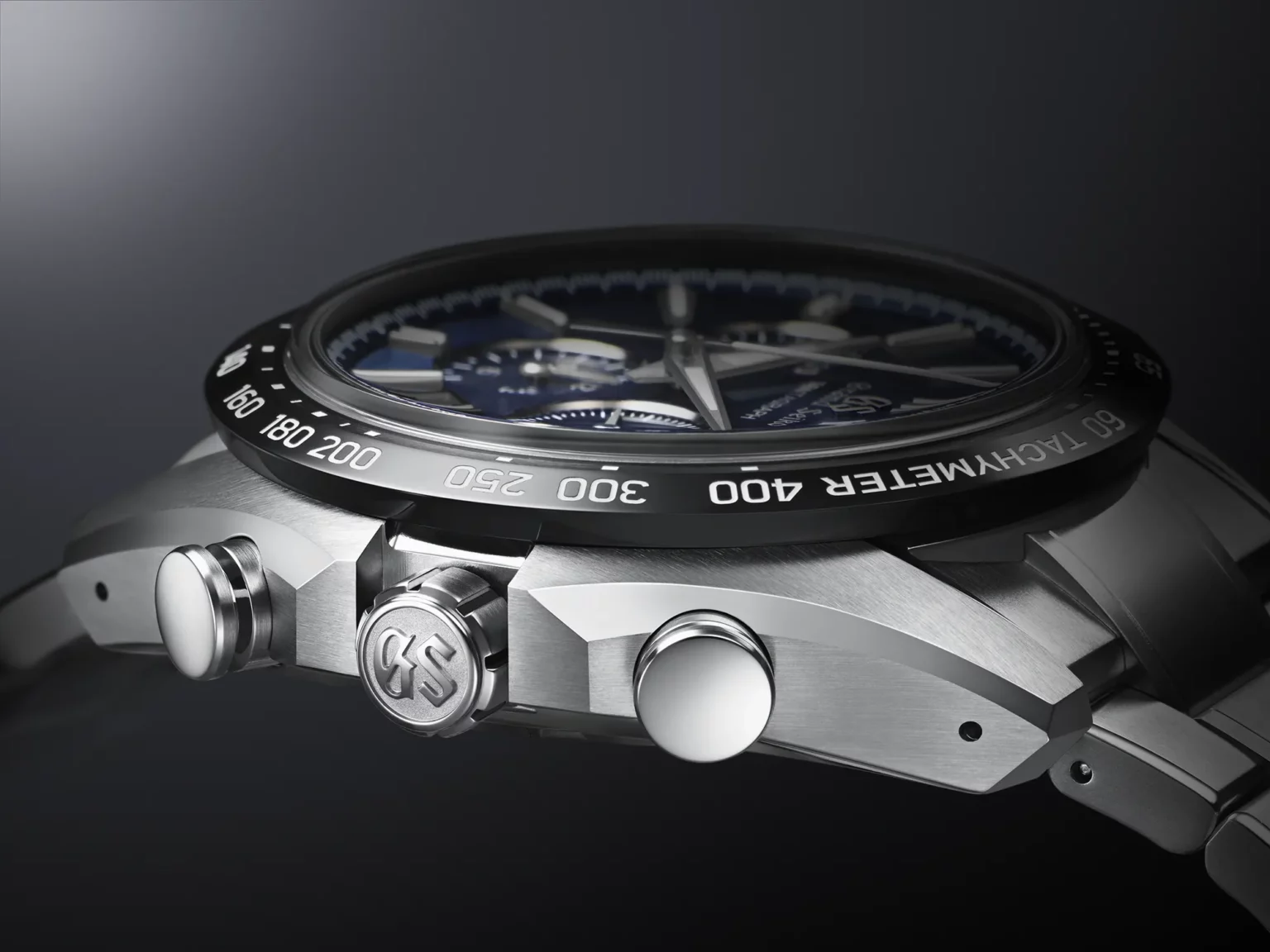
Grand Seiko’s endeavor to create the ultimate practical watch began in 1960. The objective was to attain high accuracy, legibility, durability, and beauty with a sense of practicality. It prided itself on being the highest-grade watch crafted in Japan, competing with other watches made across the globe. Practicality is an essential part of Grand Seiko’s watchmaking philosophy, as all are made to be worn with a distinguished sense of usability — easy to read, reliable, comfortable, and easy to maintain.
While Grand Seiko’s philosophy nearly required a simple display of time, people’s practical needs changed and evolved as the years passed. The more dramatic changes, and subsequent inclusion of additional features, began in the early 2000s, with the addition of GMTs, diver’s watches and, eventually, in 2007, Grand Seiko’s first chronograph, the Spring Drive Chronograph GMT caliber 9R86.

A chronograph is an interesting feature for Grand Seiko because its practicality depends on the user. When Grand Seiko introduced the Spring Drive Chronograph GMT, it met a need and boasted the highest accuracy of any self-winding chronograph. An essential part of a chronograph is the need for precision, which Spring Drive does incredibly well. Since around that time, fans and collectors of Grand Seiko have desired to see a mechanical chronograph. However, the demands would prove to be difficult as a conventional automatic chronograph can significantly decrease the amplitude of the balance wheel when the chronograph is running and, in turn, decrease accuracy. The thought that only Spring Drive would be compatible with a chronograph feature in Grand Seiko was seemingly set in stone.
In 2020, however, things changed. A new mechanical Hi-Beat 36000 caliber known as 9SA5 was introduced. This new caliber, designed by Grand Seiko movement designer Hisashi Fujieda, introduced several significant innovations that brought a new level of efficiency into play. First, since the high frequency of 36,000 vph is quite power-consuming, the caliber 9SA5 introduced the first two-barrel system set in parallel in Grand Seiko’s history, known as Twin Barrels. This enabled a long duration of 80 hours. The movement was thinner than previous generations due to the Horizontal Gear Train, a new structure that maintains the height of the gear train within the height of the twin barrels and ratchet wheels.

Third was the introduction of the Grand Seiko Free-Sprung Balance and overcoil. This overcoil helps improve the concentricity of the shape of the hairspring during oscillation across positions. At the same time, the free-sprung balance ensures a more stable precision long-term and higher shock resistance than a watch using a regulator. It allows for adjustments of the rate via the meantime screws on the balance, but also the beat error can be adjusted thanks to a rotatable stud affixed to the end of the uniquely shaped overcoil, which was determined after 80,000 simulations and utilized the data of the varying shapes to allow for this adjustment never before possible in a free-sprung balance.
Most importantly, in the introduction of the 9SA5, the new and innovative Dual-Impulse Escapement was introduced. This escapement was developed to improve the efficiency of energy delivery from the two barrels through the gear train and delivered to the balance wheel. Much like a conventional lever escapement, the Dual-Impulse Escapement indirectly delivers power to the balance via the sliding action of the escape wheel across the impulse plane of the pallet jewel through the pallet fork and to the impulse pin attached to the balance staff.


However, more uniquely, the escapement also delivers energy directly to the balance, similar to a detent escapement, where the escape wheel propels the balance wheel via the teeth of the escape wheel, directly colliding with a jewel attached to the side of the balance roller, allowing for the direct delivery of energy. This new escapement provides an efficiency approximately 20% greater than that of the already highly efficient 9S85 caliber, which uses a lever escapement that is improved via components manufactured with MEMS.
MEMS allows for parts with more intricate designs, which reduces weight, enhances friction resistance due to smoother surfaces, and even adds a lubricant retention step on each tooth to preserve lubricant over a longer course of time. Naturally, the MEMS manufacturing method is also applied to the Dual-Impulse Escapement of caliber 9SA5, and though their designs are dramatically different, all those same benefits are still applied.
It is important to understand the details of the Caliber 9SA5 to understand how Grand Seiko could potentially introduce a mechanical chronograph. It could have been assumed many years ago that if Grand Seiko were to create this type of caliber, it would have to be Hi-Beat 36000 due to the high stability and precision attainable with this frequency. But the key breakthrough, possibly unknown at the time, would be the introduction of the new Dual-Impulse Escapement, allowing for an incredibly high energy transmission efficiency.
At Watches and Wonders 2023, Grand Seiko proudly unveiled its first mechanical chronograph, known as the Tentagraph! This TEN-beat, Three days, Automatic chronoGRAPH boasts a high vibration rate of 36,000 vph and has the world’s longest power reserve for a watch of this frequency based on Grand Seiko’s research as of March 2023.

The Tentagraph is based on caliber 9SA5 with a modular chronograph mechanism incorporated. In previous years, it was said that “9SA5 is more than just a new caliber. It is an entirely new movement and the foundation upon which a whole new generation of Grand Seiko mechanical watches will be created. Deploying all the skills and experience we have gained over the past 60 years, 9SA5 is, beyond doubt, the finest mechanical caliber that we have ever created.” With that said, it can now be seen that there was a clear meaning in saying that 9SA5 was intended to be a base movement and could potentially incorporate additional features, such as a chronograph. It is also an exciting thought of what the future holds.

The new Tentagraph Caliber 9SC5 was the perfect adaptation for Grand Seiko’s first mechanical chronograph. With all the said benefits of Caliber 9SA5 at its base, the high efficiency of the escapement becomes its most vital characteristic. Though modular chronographs typically experience a more significant loss of amplitude during operation, The Caliber 9SC5 reduces the loss of amplitude compared to other modular chronographs. It maintains a higher amplitude than many integrated chronographs. Because of this merit, retaining stable amplitude with the chronograph in use made it possible for Grand Seiko to make a mechanical chronograph worthy of the brand’s values.

To fully showcase the capabilities of this new mechanical chronograph movement, Grand Seiko has also introduced a new standard specific to mechanical chronographs that requires a mean daily rate of -3 to +5 seconds per day, testing across 17 days, three temperatures, and six positions without the chronograph in use. However, in addition, this new GS Standard will include three additional days of position testing with the chronograph in use, creating testing criteria of 20 days. The addition of the chronograph running in the test is not applied to chronographs submitted using COSC or ISO chronometer standards. It pushes to enforce the quality of the movement further while the chronograph is in use.


For the chronograph module, functionality is critical. The use of a column wheel is implemented to provide a reliable, error-free operation that provides a noticeable “click” when the pushers are depressed. Along with the column wheel, a vertical clutch provides a shudder-free operation of the second hand when starting the elapsed time measurement. By dropping the clutch to engage with the driving seconds vertically, as opposed to horizontally meshing gears together, the engagement is smooth and precise, eliminating the possibility of teeth slipping due to their lateral engagement and misalignment of the teeth when interacting. This may cause the gear to shift backward, in turn making the second hand shudder. The vertical clutch eliminates this imprecision. The use of the vertical clutch and column wheel mechanism has deep roots within both former Seikosha factories in the late 1960s and through the 1970s. In 1969 Suwa Seikosha (Now Seiko Epson) introduced the 6139 calibers as the world’s first automatic chronograph incorporating a vertical clutch and column wheel system. The following year, Daini Seikosha (now Seiko Watch Corporation) introduced the caliber 7016, including the vertical clutch and column wheel system but in a thinner profile. Over the decades, both Seiko and later Grand Seiko have continued the pursuit of high-grade chronographs utilizing this system, and the knowledge and know-how of past developments have proven the value and performance of this method of measuring elapsed time.

The introduction of the Tentagraph Caliber 9SC5 required an impressive aesthetic. Grand Seiko Style, its unique design grammar, was established in 1967 in the introduction of the 44GS. This design code was evolved for the modern day by Grand Seiko designer Kiyotaka Sakai in 2020. This newly established design code was later introduced as the Evolution 9 Collection, and at Watches and Wonders 2022, sport model iterations were added to the lineup. For the Tentagraph, a new take on the Evolution 9 was conceived and harmonized with the new movement.
The Evolution 9 aesthetic is similar to that of the original Grand Seiko Style; however, a focus on improved legibility through wider and grooved, highly faceted indexes and distinct shapes for the hour and minute hands creates incredible legibility and a bold dial. The Tentagraph adds Lumibrite, a proprietary luminous paint, to the indexes and hour and minute hands. The case shape involves many intersecting planes, alternating mirror-finished surfaces with a soft hairline finish, with sharp edges formed by the acclaimed Zaratsu polishing technique. The bezel is made of zirconia ceramic for high durability and scratch resistance and adds a tachymeter, an uncommon trait on a Grand Seiko bezel.

Comfort is the emphasis for Evolution 9. The wide and thick bracelet and a case with a low center of gravity help create a sense of balance on the wrist. The use of high-intensity titanium alloy gives a lightweight feel but creates high scratch and corrosion resistance for long-term usability. The clasp also features micro-adjustments but is not oversized compared to the bracelet. The pushers stand out compared to some of the Spring Drive Chronograph GMTs, as the Tentagraph has a low profile yet is still highly functional. They are in line with the crown, despite the modular structure.


The multi-layered dial improves legibility with recessed sub-dials for the chronograph hour and minute counters and continuous running seconds. The stunning texture expresses the ridges of Mt. Iwate, as seen from above, radiating out of the dial’s center. This dial pattern was first implemented in Grand Seiko in 2006 and is exclusively used alongside the 9S series of calibers, which are made at Grand Seiko Studio Shizukuishi in Iwate Prefecture, Japan. A symbol of Iwate, the mountain has also become synonymous with Grand Seiko mechanical watches. The studio that crafts these timepieces often pays tribute to the peak, as seen from their windows. The medium shade of blue pays homage to the night sky over Mt. Iwate, and its subtlety and charm only further enhance this amazing new addition to the lineup.
The Grand Seiko Tentagraph SLGC001 will be a continuing production model, available exclusively at Grand Seiko Boutiques and Salons starting in June 2023.












